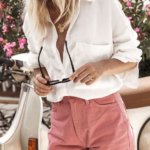 We wouldn’t believe half so heartedly that Gwen Stefani could be this unbelievably chic, if she wasn’t on the cover of Vogue this month. If she were on Rolling Stone’s cover we’d nod a bit – “yes, we know.” But she’s not, now is she? She’s showing up as the “first lady of rock” in Gavin Rossdale’s droopy black tank top, and she’s on the cover of Vogue. That matters. That’s different.
We wouldn’t believe half so heartedly that Gwen Stefani could be this unbelievably chic, if she wasn’t on the cover of Vogue this month. If she were on Rolling Stone’s cover we’d nod a bit – “yes, we know.” But she’s not, now is she? She’s showing up as the “first lady of rock” in Gavin Rossdale’s droopy black tank top, and she’s on the cover of Vogue. That matters. That’s different.
In a similar way, it matters where you show up, and how you choose to do so. In fact, it matters almost more than anything.
I recently heard entrepreneurship described as the marketing of a lifestyle. “You’re not just selling a product or a service,” a friend said to me. “You’re selling a way of being.” He pointed out that entrepreneurship is the process of proving that 1. Your customers should want the kind of lifestyle you’re presenting and 2. Showing how your product makes it accessible.
He gave the example of a colleague of his that opened a health food restaurant by the ocean. His friend didn’t have any previous experience in the food industry. He couldn’t cook. But he believed that if he could sell a way of being, everything else would fall into line.
“We all assumed he was just talking about selling food,” my friend recalled. “But he wasn’t. He was talking about something much, much bigger.”
My friends colleague focused first on ensuring that everything involved in the business was congruent with the lifestyle they were selling. Everything else came second. He is now the owner of a handful of extremely successful restaurants, in various locations near the ocean.
My friend’s story describes the essence of branding – the process of turning a product or service into a movement, lifestyle or philosophy. Being, for instance, on the cover of Vogue versus Rolling Stone, or having your product placed on Kesha versus Christina Milian – or being stocked in fitness stores versus showing up in a small boutique in lower Manhattan.
Branding is what helps us differentiate between one product and another. It shows us reasons to make buying decisions. It gives us a reason to feel connected to certain providers and products. And, it’s absolutely necessary to entrepreneurial success.
Here are a few key factors to building yours:
1. Graphic design
The packaging of your website, advertising, printed materials and the aesthetic of your social media sites together should all give one congruent message about who you are, and what feeling people should get when they come to your site. Here’s a blog my graphic designer wrote about the inspiration behind her work on Nakate’s design last summer.
2. Social media
Your social media sends a message every time you post on facebook, instagram, twitter or (insert your platform of choice here). It shows what is important to your company, how you interact with your customers, the tone of your language, the information you believe to be worth sharing, the photos and media you provide and the events you attend. Good examples on brands using twitter and instagram to reflect their brand personality is @dkny and Oscar de la Renta @Oscarprgirl. Learn from the best my friends!
3. Events
Carefully choose which events you are part of. Is it a street fair you want to vend at, or a high end showroom event? Do you want to meet people at a cocktail hour, or at an academic event? Will your potential financial backers or customers be at charity benefits or business mixers? Or, perhaps both? And, in that case, what kind? The events you attend and take part in will determine both determine who you meet, and how people perceive your brand.
4. Purchasing power
As a business owner working in the ethical fashion market, I don’t buy just any clothing. I work hard to ensure that I make smart purchases, support other designers and companies in my field, and choose to put my “money where my mouth is,” so to speak. I ensure my wardrobe is of the moment. But, it’s not just that. I ensure that the gifts I give, the clothing I purchase and the brands I support all point back to the truth that sustainable and ethical fashion matters, and I believe in my field. I am using my purchasing power to showcase the value of my lifestyle, and to prove that it’s accessible and attractive. Your purchasing decisions should show that you value your brand as more than a concept. You take it on as a lifestyle.
5. Presence
Just as Vogue showed us the sophisticated side of Stefani, the blogs, publications and sites where you choose to run giveaways, conduct interviews or showcase your product affect the perception of your brand and yourself. Choose these platforms carefully.









